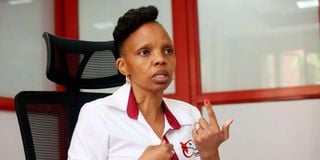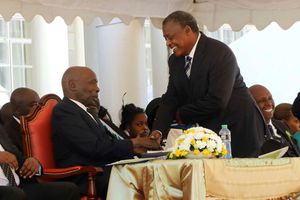Premium
How is university placement done that many students miss their course choices?

Dr Agnes Mercy Wahome, the CEO of Kenya Universities and Colleges Central Placement Service.
What you need to know:
- As part of our mandate, we carry out career guidance programmes for students and help them to choose courses.
- We have put a lot of effort into ensuring that those who sat KCSE exam early this year will still join in September.
The method used for selection of university courses is based purely on KCSE scores as aggregated through the system. Is KUCCPS prepared to embrace modern methods of student selection that matches their career aspirations? Kepher Orina, Riverside, Nairobi
Yes, the selection is based on students’ KCSE grades, but that is not all. We allow students to choose four different courses, which they arrange in the order of priority. After placement has been done, we give them opportunity to transfer institutions and possibly change courses, offering them another chance to further align themselves with desired careers.
In addition, as part of our mandate, we carry out career guidance programmes for students and help them to choose courses. KUCCPS is also working on a career expert system that will enable students to understand themselves better and discern the careers that best suit them.
Can you consider devolving the cereer guidance services? Stanslaus Mogeni, Nyamira
We appreciate the feedback that our career forums are useful. This is a priority area that we are keen on expanding, to ensure that we reach more students, parents and teachers. In addition, we are setting up stations in Huduma Centres and have established 11 so far. We are also very active on social media, where we connect with thousands of youths seeking career guidance and information.
There are some universities that are not among the institutions that admit government-sponsored students. Is it by choice or could it be that they have not met certain requirements set by KUCCPS? Janerose Wangari, Lower Kabete
Only two universities, which are private, have not registered with KUCCPS to enrol students for government sponsorship. This is by choice. All the 38 public universities and their constituent colleges, and 33 private universities admit government-sponsored students through KUCCPS and this is voluntary.
Are some of the gains made in delocalisation of student enrolment being reversed and eroded through uncontrolled student transfers to institutions of choice? Komen Moris, Eldoret
I appreciate that you recognise our effort towards national cohesion and integration through the delocalisation of students. One of the main reasons students transfer is lack of accommodation in some institutions. To mitigate this, KUCCPS is encouraging institutions to invest in affordable accommodation for students to reduce the need for transfers.
How has Covid-19 pandemic affected your operations as an institution? Komen Moris, Eldoret
With regard to student placement, we have not been affected as we had already automated the process. However, the pandemic affected the education calendar, which has delayed the placement calendar. We used to finish the annual placement cycle by April for the students to join their institutions in September. This year, we intend to finish by the end of July.
We have put a lot of effort into ensuring that those who sat KCSE exam early this year will still join in September to save the academic calendar for universities and colleges. In terms of career guidance, we used to visit schools and conduct physical career exhibitions, which have been greatly affected. To mitigate this, we have embraced online student career guidance and career teacher sensitisation forums.
KUCCPS moved from annual placement of students to diploma courses to semester basis. This means that in some institutions, some classes may be separated by just a semester, thus putting pressure on the institution's human and physical resources. Was this decision taken in consultation with the accredited institutions? Steve Bowen, O’Lessos
We place students to TVET institutions in three cycles. The institutions are the ones to guide the students on when to report, based on their calendar. We do not dictate to them when the students should report. Once we place, we encourage the institutions to agree with the students on when to report, based on the available resources. We also encourage them to introduce open, distance and e-learning (ODEL) and blended learning where possible.
From Joint Admission Board (JAB) that was an association of public universities to KUCCPS with an established legal framework, what has been the improvement from this transition? Mercy Wandia, Kamulu
The transition has given KUCCPS a legal framework with a well-defined mandate, which is to coordinate the placement of government sponsored students to universities and colleges; disseminate information on available programmes, their costs, and the areas of study prioritised by the government; collect and retain data relating to university and college placement; advise the government on matters relating to university and college student placement; develop career guidance programmes for the benefit of students; and perform any other function assigned to it under the Universities Act. It has also expanded the opportunities of government sponsorship for students to public universities, private universities, and TVET colleges.
KUCCPS seems to have made inter-institutional transfers so cumbersome that students just give up before they start. The requirement for concurrence from the institution one wishes to join and the other that one had been placed in means that one has to physically travel to the two institutions which may be hundreds of kilometres apart. Isn’t there an easier and better way of handling this, a clearing house of sorts? Benson Obago, Siaya
The transfer process is automated through an online portal, which opens for a specific period after the placement of students has been done. When transfers are done outside the official period, we encourage applicants to forward their letters by email to the receiving and releasing institutions. Hence, the whole process can be done without physical visits to all the institutions.
Many students meet the requirements to study courses like engineering but only a few are selected. What criteria does KUCCPS use to ensure that only a few are selected? Kamau Mwangi, Kinoo
It is all about the available capacity. For instance, if all universities combined have only 100 spaces for engineering and more than 100 students who are qualified for the course apply, the system orders them from the highest to the lowest and allocates them the course in that order until the capacity is filled.
This leaves out those at the bottom of the ranking. When one misses a programme, there is also an option of pursuing it as a self-sponsored student. As we open for the second revision on June 22, we encourage students to consider other programmes instead of restricting themselves to the perceived coveted programmes.
However, one of the biggest mistakes that students make while selecting programmes is considering the choice of university ahead of the course. From our experience, the challenge is more often about selecting the highly demanded courses in highly coveted universities. If a student really desires a course, we encourage them to apply for it in universities where they will likely face less competition.
Next week: Dr Mzalendo Kibunjia, Director General National Museums of Kenya





